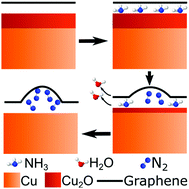当前位置:
X-MOL 学术
›
Phys. Chem. Chem. Phys.
›
论文详情
Our official English website, www.x-mol.net, welcomes your
feedback! (Note: you will need to create a separate account there.)
Intercalation, decomposition, entrapment – a new route to graphene nanobubbles
Physical Chemistry Chemical Physics ( IF 2.9 ) Pub Date : 2020/03/17 , DOI: 10.1039/d0cp00592d Khadisha M. Zahra 1, 2, 3, 4, 5 , Conor Byrne 1, 2, 3, 4, 5 , Adriana Alieva 1, 2, 3, 4 , Cinzia Casiraghi 1, 2, 3, 4 , Alex S. Walton 1, 2, 3, 4, 5
Physical Chemistry Chemical Physics ( IF 2.9 ) Pub Date : 2020/03/17 , DOI: 10.1039/d0cp00592d Khadisha M. Zahra 1, 2, 3, 4, 5 , Conor Byrne 1, 2, 3, 4, 5 , Adriana Alieva 1, 2, 3, 4 , Cinzia Casiraghi 1, 2, 3, 4 , Alex S. Walton 1, 2, 3, 4, 5
Affiliation

|
Graphene nanobubbles (GNBs) have become the subject of recent research due to their novel physical properties. However, present methods to create them involve either extreme conditions or complex sample fabrication. We present a novel approach which relies on the intercalation of small molecules (NH3), their surface-mediated decomposition and the formation of larger molecules (N2) which are then entrapped beneath the graphene in bubbles. Our hypothesised reaction mechanism requires the copper substrate, on which our graphene is grown via chemical vapour deposition (CVD), to be oxidised before the reaction can occur. This was confirmed through X-ray photoelectron spectroscopy (XPS) data of both oxidised and reduced Cu substrate samples. The GNBs have been analysed through atomic force microscopy (AFM, after NH3 treatment) and XPS, which reveals the formation of five distinct N 1s peaks, attributed to N2 entrapment, N doping species and atomic nitrogen bonded with the Cu within the substrate. This method is simple, occurs at low temperatures (520 K) and integrates very easily with conventional CVD graphene growth, so presents an opportunity to open up this field of research further.
中文翻译:

嵌入,分解,截留–石墨烯纳米气泡的新途径
石墨烯纳米气泡(GNB)由于其新颖的物理特性而成为近期研究的主题。但是,当前创建它们的方法涉及极端条件或复杂的样品制造。我们提出了一种新颖的方法,该方法依赖于小分子(NH 3)的插入,它们的表面介导的分解以及大分子(N 2)的形成,然后将其困在石墨烯下的气泡中。我们假设的反应机理需要铜基板,通过石墨基板在其上生长我们的石墨烯化学气相沉积(CVD),必须先氧化才能发生反应。通过氧化的和还原的铜基质样品的X射线光电子能谱(XPS)数据可以证实这一点。已通过原子力显微镜(AFM,在NH 3处理后)和XPS分析了GNB ,这揭示了五个不同的N 1s峰的形成,这归因于N 2的俘获,N掺杂物质和与基板内Cu结合的原子氮。该方法简单易行,在低温(520 K)下发生,并且非常容易与常规CVD石墨烯生长集成,因此为进一步开拓这一研究领域提供了机会。
更新日期:2020-04-08
中文翻译:

嵌入,分解,截留–石墨烯纳米气泡的新途径
石墨烯纳米气泡(GNB)由于其新颖的物理特性而成为近期研究的主题。但是,当前创建它们的方法涉及极端条件或复杂的样品制造。我们提出了一种新颖的方法,该方法依赖于小分子(NH 3)的插入,它们的表面介导的分解以及大分子(N 2)的形成,然后将其困在石墨烯下的气泡中。我们假设的反应机理需要铜基板,通过石墨基板在其上生长我们的石墨烯化学气相沉积(CVD),必须先氧化才能发生反应。通过氧化的和还原的铜基质样品的X射线光电子能谱(XPS)数据可以证实这一点。已通过原子力显微镜(AFM,在NH 3处理后)和XPS分析了GNB ,这揭示了五个不同的N 1s峰的形成,这归因于N 2的俘获,N掺杂物质和与基板内Cu结合的原子氮。该方法简单易行,在低温(520 K)下发生,并且非常容易与常规CVD石墨烯生长集成,因此为进一步开拓这一研究领域提供了机会。











































 京公网安备 11010802027423号
京公网安备 11010802027423号